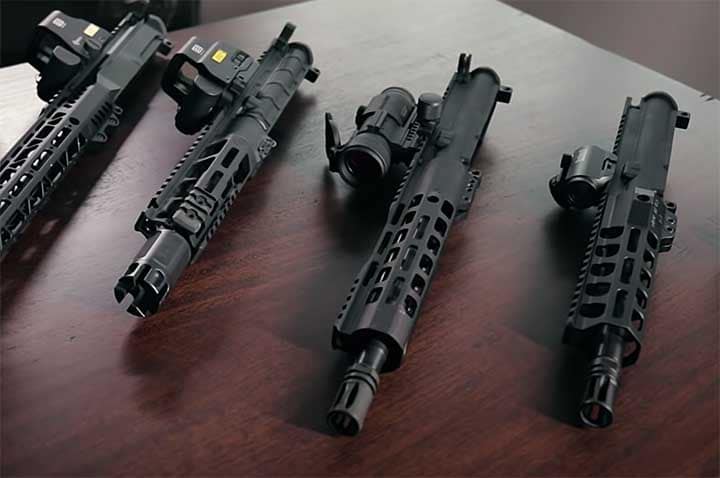
Red dot sights and holographic sights often get lumped into the same category. Uninformed shooters may even use the terms interchangeably. While both red dots and holo sights have the same job (which is to produce an aiming reticle so you can make more rapid and accurate shots), the technology is based on two completely different principles. Because these two types of optics function so differently, they each perform differently in different situations.
Let’s take a closer look at how these two popular sighting options work. Once you understand how the technology differs, you can begin to appreciate what each does best. By the end of this article, you’ll be able to make an informed decision about which one will work best for you.
Table of Contents
What is a Red Dot?
A red dot sight uses an LED emitter to bounce a beam of light off a specially coated front lens. The glass bounces the light shaft back toward the shooter’s eye, which he or she can then use as a red dot aiming point.
What is a Holographic Sight?
Holographic diffraction sights, better known as holographic sights or simply “holo” sights, are a whole other category of weapon optics. Pioneered by the legendary EOTech Inc., holo sights use lasers and mirrors to transmit an image of a reticle that appears to float over the shooter’s target. As an added bonus, holo sight technology can create a reticle with more detail than a simple dot.
While red dot sights make your eye shift focus on the dot (a closer focal point) and the target (a more distant focal point), holo sights make the job easier for your brain. Because the holo reticle seems almost superimposed over the target, your eye only needs to focus on one thing: your target.
Red Dot vs Holographic Sights
Weighing the Options
Deciding between a red dot and a holographic sight is not an easy undertaking and deserves careful consideration. Here’s how each optic type measures up in some key factors.
Price
Unfortunately, most of us don’t have an unlimited optics budget. Although price shouldn’t be the ultimate determining factor in choosing a sight, we understand how important it is to stick to a budget.
Because holo sights use more complicated technology than red dots, they also come with much higher price tags. Most holo sights will cost several hundred dollars more than the average red dot.
If you’re looking for a budget-friendly optic, red dots easily beat holo sights in this category.
Size
While neither sighting option would ever be considered hefty, there are some amazing micro red dots on the market. If you want to run something tiny, a red dot is the way to go.
Because of the internal technology, holo sights also tend to be a bit heavier than most red dots.
Durability
With the right amount of cash, you can invest in literally bombproof options in both categories. For example, the Aimpoint PRO is a red dot optic that has proven its durability in combat situations around the globe. Likewise, EOTech’s holo sights have charged into battle with US special operations units. Both optics can handle submersion, temperature extremes, g-forces, insane recoil, and rough handling without breaking a sweat.
However, holo sights have a major edge in the durability category – they don’t need a front window to function. Whether the front glass is obscured by mud, dirt, or blood, the reticle will still function, remaining visible to the shooter. A holo sight even keeps working when the front glass shatters completely or is partially missing. There really isn’t much that a holo sight can’t handle.
Target Acquisition Speed
Both red dots and holo sights are designed to get you on target quickly and accurately. There is no argument that both of these optics are significantly faster to use than iron sights.
However, holo sights are the kings of acquisition speed. Because the reticle is a hologram projected out in front of the sight, the shooter’s eye can focus more quickly and easily on the target.
As an added bonus, holo sights have more detailed reticles. The classic circle dot reticle featured in most holo sights is incredibly versatile. It allows you to use the outer ring for up-close, on-the-fly shots and then switch to the center dot for precision shooting at distance.
Night Vision
If you need to use your optic after the sun goes down, you’ll need to choose a model that is night vision compatible. Luckily, there are both red dots and holo sights designed to compliment your night vision device (NVD). These models feature dimmer, night vision-friendly settings to protect your NVD.
Magnification
Traditional red dots and holo sights are not magnified. If you need to bring distant targets into focus, you’ll need to mount a magnifier in front of your sight.
If you’re running a red dot with a 2 MOA aiming point, a magnifier increases the size of the dot to a whopping 6 MOA. A dot that size will cover quite a bit of your target, making precision long-range shots problematic. A thicker reticle can also clutter up your sight picture when engaging targets at closer range.
However, adding a magnifier in front of your holo sight doesn’t increase the perceived size of the dot. Although a holo paired with a compatible magnifier will increase the apparent size of your target, the aiming point remains the same size. The relatively fine dot minimizes target coverage and promotes precision accuracy.
Astigmatism
Astigmatism is a vision impairment caused by a misshapen cornea or eye lens. Shooters with astigmatism struggle with blurred vision and often see a glare or halo around streetlights. This condition also makes it difficult for shooters to focus on a red dot reticle.
While holo sights are not completely astigmatic aberration-free, their design helps minimize the haloing or glare effect common with most red dots sights.
Battery Life
Top-quality holo sights have a respectable battery life of about 500 hours. If you think that’s impressive, compare it to the average red dot, which offers approximately 500,000 hours of use before you’ll need to swap out the batteries. That means you could accidentally leave your red dot sight powered on for five years, and when you come back, it will still be chugging along.
Field of View
Red dots and holo sights are designed to be used with both eyes open. This extends the field of view, which preserves your peripheral vision and situational awareness in fast-paced shooting scenarios.
Smaller micro red dots often have tiny windows. While this doesn’t necessarily shrink your field of view, it can mean you’ll need to get well behind the optic to ensure a proper sight picture.
Reticles
The traditional color for red dot and holo sight reticles is obviously red. Many modern models are also now available with green reticles. Green is much easier for the human eye to see. A green reticle also reduces eye strain, which is a major perk if you spend a lot of time staring at your reticle.
But there’s more to reticles than color. While red dots provide only a simple dot, holo sights use reticles with a little more detail. The most common holo reticle is the “speed ring,” which consists of an outer circle and a small center dot. The outer ring is designed for rapid target acquisition, but it does serve another handy purpose: ranging targets.
At 100 yards, a human-sized target will fill the ring with feet at the bottom and head touching the top. At 200 yards, the average man will take up half the ring. In other words, you can place the center dot on his head, and his feet should touch somewhere on the bottom ring. This feature is useful in tactical situations as well as competition, especially where targets present at unknown distances.
We mentioned earlier that holo sights also have a smaller 1 MOA dot. The finest red dots are a beefier 2 MOA, which covers two inches on a 100-yard target. The further the target, the more of it will be covered by the red dot reticle. This can cause problems with precision on more difficult long-range shots. The problems only increase when you add a magnifier in front of your red dot.
If you need your optic for longer-distance shooting, a holo is hard to beat. Even when you add a magnifier, the center dot remains a constant 1 MOA, making precision shooting much easier.
Final Thoughts
It’s difficult to argue the benefits of a holographic sight. These high-tech optics are real performers on the battlefield and the competition field. However, the technology comes with a much steeper price tag, which could be a major deterrent for shooters with limited budgets. Thankfully, there are plenty of quality, affordable red dots on the market today.
Still, if you have the patience to save your hard-earned dollars, you won’t be disappointed in the way a holo sight performs.

Leave a Reply